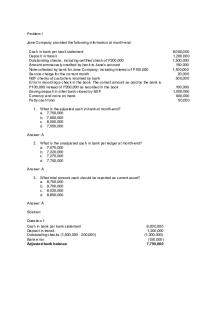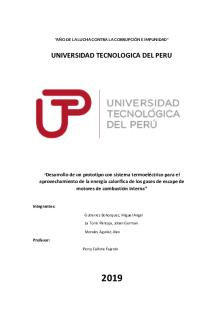Law-summary-part-2 compress PDF

| Title | Law-summary-part-2 compress |
|---|---|
| Course | Remedial Law 6 (Law Practicum 2) |
| Institution | University of the Philippines System |
| Pages | 6 |
| File Size | 124.1 KB |
| File Type | |
| Total Downloads | 3 |
| Total Views | 277 |
Summary
GENERAL PROVISIONS Corporation – an artificial being created by operation of law having the right of succession and the powers, attributes, and properties expressly authorized by law or incident to its existence. Fiction of corporate entity – a corporation is a legal entity or a person in law, di...
Description
GENERAL PROVISIONS Corporation – an artificial being created by operation of law having the right of succession and the powers, attributes, and properties expressly authorized by law or incident to its existence. Fiction of corporate entity – a corporation is a legal entity or a person in law, distinct from the persons composing it. Stock corporation – ordinary business corporation created and operated for the purpose of making a profit which may be distributed in the form of dividends to stockholders. Capital stock – amount fixed in the articles of incorporation Outstanding capital stock – portion of the capital stock which is issued and held by persons other than the corporation itself Cumulative preferred share – share which entitles the holder thereof not only to the payment of current dividends but also to dividends in arrears Treasury share – shares of stock which have been issued and fully paid for, but subsequently reacquired by the issuing corporation by purchase, redemption, donation or through some other lawful means. Promoters – persons who bring about or cause to bring about the formation and organization of a corporation by bringing together the incorporators or the persons interested in the enterprise.
5.
6.
7. 1. Give at least 4 distinctions between a corporation and a partnership. PARTNERSHIP CORPORATION created by mere created by law agreement organized by two requires at least 5 persons only commences juridical commences only from personality at the the date of the issuance execution of the contract of certificate of of partnership incorporation by SEC when the management the power to do is not agreed upon, business and manage every partner is an its affairs is BOD or BOT agent 2. Distinguish share of stock from capital stock. o Share of stock is used in a distributive sense to refer to the stock in the hands of the stockholders (it belongs to them). Capital stock signify the whole body of shares of stock in the corporation.
3. Give at least 3 advantages and 3 disadvantages of no par value shares. ADVANTAGES DISADVANTAGES Issued as fully paid and Legalize large issues of non-assessable stock for property Price is flexible Conceal the money or property represented by the shares Low-priced stocks Promote issuance of enjoy wider distribution watered stock
Corporators – compose the corporation, whether stockholders or members o Incorporators – corporators mentioned in the articles of incorporation o Stockholders – owners of shares of stock o Members – corporators of a corporation which has no capital stock Give at least 3 advantages and 3 disadvantages of a business corporation. ADVANTAGES DISADVANTAGES Legal capacity to act as Complicated a legal unit Has continuity of Entails high cost of existence formation Management is Lack of personal element centralized in the BOD in view of the transferability of shares Creation, organization, Stockholders have little management and voice in the conduct of dissolution are the business. standardized Illustrate a cumulative preferred share. o If the stipulated dividend is not paid in a given year, it shall be added to the dividend which shall be due the following year and the accumulated dividends must be paid to the holder of said preferred share before any dividend may be paid to the holders of common stock. Give at least 4 similarities between a corporation and a partnership. Like partnership, o a corporation has a juridical personality separate and distinct from that of the individuals composing it; o a corporation act only through agents; o a corporation is an organization composed of an aggregate of individuals. Distinguish share of stock from certificate of stock. o Share of stock is incorporeal or intangible property while certificate of stock is tangible. Share of stock represents the right/interest of a person in a corporation, while certificate of stock is the written evidence of that right/interest. o
8.
Congress passed a proposed law creating a corporation to engage in agricultural activities. Is the law valid? It depends. Corporations cannot come into existence by mere agreement of the parties. Legislative grant or authority is necessary for the creation of a corporation with respect to corporations by prescription. X, Inc. and Y, Inc. are sister companies with the same set of officers. May X be held liable for the obligations of Y? It depends. A corporation may be allowed to exist solely for lawful purposes but where the fiction of corporate entity is being used as a cloak to cover for fraud or illegality, the individuals composing it will be treated as identical. One instance where fiction is disregarded is where a subsidiary company is created by a parent company merely as an agency of the latter especially if the stockholders or officers of the two
4. Who are the 4 classes of persons composing a corporation. Identify them.
corporations are substantially the same or their system of operations is unified.
If the book value of the share of stock in a corporation is P100, is this amount also its par value and market value? It depends. The par value does not always reflect its actual or true value or book value which may be determined by dividing the net value of the total corporate assets by the number of shares issued or outstanding. Par value and market value may be more or less than market value but market value is affected by the law of supply and demand. The articles of incorporation provides that a particular class of shares shall be deprived of the right to vote. Nevertheless, may they be still entitled to vote? Yes. Under the Code, no share may be deprived of voting rights except those classified and issued as “preferred” or “redeemable” shares, unless otherwise provided in the code. A corporation issued redeemable shares in favor of S who informs the corporation of his option to redeem the same as provided in the articles of incorporation. Has C, a corporate creditor, the right to object? It depends. Pp. 256-257 A corporation voted its treasury shares and received dividends thereon. Can the corporation do these? No. Treasury shares have no voting rights as long as they remain in the treasury. Neither are treasury shares entitled to dividends or assets because dividends cannot be declared by a corporation to itself as such distribution would be like taking money or stock from one of its pockets and putting the same in another, which would be pointless. The treasury shares were acquired by the corporation at P100 per share. May the corporation sell them at only P50 per share? It depends. Treasury shares may be resold by the corporation at any price the board of directors sees fit to accept, even at less than par. A stockholder, dissatisfied with the management of the corporation, surrenders his certificate of stock and demands the return of the subscription price paid by him. Can he rightfully do this? No. Shares of stock do not constitute an indebtedness of the corporation to the shareholder and are, therefore, not credits. Hence, no action can be maintained against the corporation for the return of the contributions of the shareholders as long as the corporation needs them and is not under dissolution. INCORPORATION AND ORGANIZATION OF PRIVATE CORPORATIONS Articles of incorporation – document prepared by the persons establishing a corporation and filed with the SEC. De facto corporation – one which actually exists for all practical purposes as a corporation but which has no legal right to corporate existence as against the state. De jure corporation – one created in strict conformity with the mandatory statutory requirements for incorporation. Collateral attack – one whereby corporate existence is questioned in some incidental proceeding not provided
by law for the express purpose of attacking the corporate existence. 1. What are the requisites in the statement of the purpose or purposes for which a corporation is formed? a. Lawful b. Purpose/s must not be indefinitely stated c. Primary purpose must be stated d. Must be capable of being lawfully combined 2. May individuals organize a corporation by mere agreement like in the formation of a general partnership? Explain. a. No. The right to be and act as a corporation does not belong to any person as a natural and civil right, but as a special privilege conferred upon a group of persons by the sovereign power of the state. 3. How shall the 25% subscription requirements be computed where the capital stock consists only of par value shares? a. The minimum subscription should be 25% of the amount of authorized capital stock or 25% of the aggregate value of all the shares of stock the corporation is authorized to issue. 4. What are the essentials for the existence of a de facto corporation? a. Valid law under which a corporation with powers assumed might be incorporated b. A bona fide attempt to organize a corporation under such law c. Actual user or exercise in good faith of corporate powers A corporation was continuously inoperative for 3 years. Is the corporation deemed dissolved? It depends. If the corporation does not formally organize and commence its business or the construction of its works within 2 years from the date of incorporation, its corporate powers cease and the corporation shall be deemed dissolved. However, if a corporation has commenced the transaction of its business but subsequently becomes continuously inoperative for a period of at least 5 years, the same shall be a ground for the suspension/revocation of its corporate franchise or certificate of incorporation. 2 years before the expiration of the corporation term of existence, the corporation applied with the SEC for extension of said term. Under the law, can the extension be granted? It depends. The extension cannot be made earlier than 5 years prior to the expiration date unless there are justifiable reasons therefor as may be determined by the SEC. Under Section 10, there must be at least 5 incorporators in the formation of a corporation. X organized a corporation, together with A, B, C, and D. All the shares are admittedly owned by X who register 4 shares in the name of A, B, C, and D. Is this a violation of the mandatory requirement of minimum number of incorporators? No. The law permits the existence of corporation originally formed by the required number of incorporators affected by the subsequent accumulation of all the shares in the hands of one individual.
Under Section 13, at least 25% of the authorized capital stock must be subscribed and at least 25% of the subscription must be paid-up but the paid-up capital must not be less than P5,000. Can this requirement be complied with where the authorized capital stock of the corporation is only P20,000. Yes. The subscribed is 20,000 and the paid up is 25% or 5,000.
X, a director in a corporation, is recorded in the book of the corporation as owner of 1 share of stock. X admits that the true owner is Y, its President. Is X disqualified to be a director? No. The general rule is that the person who holds the legal title to the stock as shown by the books of the corporation is qualified although some other person may be the beneficial owner of the stock.
BOARD OF DIRECTORS/TRUSTEES/OFFICERS Quorum – such number of the membership of a collective body as is competent to transact its business or do any other corporate act. Cumulative voting for one candidate – stockholder is allowed to concentrate his votes and give one candidate as many votes as the number of directors to be elected multiplied by the number of his shares shall equal. Cumulative voting by distribution – stockholder may cumulate his shares by multiplying also the number of his shares by the number of directors to be elected and distribute the same among as many candidates. Corporate opportunity doctrine – director who acquires for himself a business opportunity which should belong to the corporation.
A vacancy occurs in the broad of directors, further reducing the number from 11 to 6 members. Who is empowered to free the vacancy, the stockholders or the incumbent directors? It depends. It may be filled by the vote of at least a majority of the remaining directors/trustees, if still constituting a quorum. Otherwise, said vacancies must be filled by the stockholders in a regular or special meeting called for that purpose.
1. State the qualifications prescribed by the Corporation Code for directs and trustees of stock and non-stock corporations. a. Own at least one share of the capital stock b. Registered in his name c. Continuously own at least a share of stock during his term, otherwise, he shall automatically cases to be a director. d. Majority must be residents of the Philippines 2. How shall the directors/trustees exercise their powers in order to bind the corporation? Give the reasons for the rule? a. They must act together as a body in a lawful meeting in order to bind the corporation by their acts. 3. Illustrate straight voting as a method in the election of directors. a. Every stockholder may vote such number of shares for as many persons as there are directors 4. Illustrate voting in a non-stock corporation in the election of trustees. a. Members of non-stock corporations may cast as many votes as there are trustees to be elected but may not cast more than one vote for one candidate. A contact was entered into in the name of corporation with the unanimous approval of all the stockholders. Is the contract binding on the corporation? No. The stockholders (or members) elect a board of directors (trustees) to oversee the management and operation of the corporation. They are not the agents of the corporation; they cannot bind it by their acts. The directors have sole authority to determine policy and conduct the ordinary business of the corporation within the scope of its charter.
X was elected director in a corporation. The other directors who supported his election, assured him a monthly compensation of P50,000. In fact, they approved a resolution granting him the compensation. Is X entitled to the compensation? No. As a general rule, when directors perform nothing more than the usual and ordinary duties of their office, they are not entitled to salary or other compensation. The reason is that directors render services gratuitously and that the return upon their shares adequately furnishes the motives for services without compensation. If a director deserves compensation for such services, the same may be granted by the vote of the stockholders. POWERS OF CORPORATION Implied powers – powers which are reasonably necessary to exercise the express powers and to accomplish or carry out the purposes for which the corporation was formed Incidental power – powers which a corporation can exercise by the mere fact of its being a corporation or powers which are necessary to corporate existence and are impliedly granted. Right of pre-emption – whenever the capital stock of a corporation is increased nad new shares of stock are issued, the new issue must be offered first to the stockholders who are such at the time the increase was made. Dividends – part or portion of the profits of a corporation set aside, declared and ordered by the directors to be paid ratably to the stockholders on demand or at a fixed price. Retained earnings – difference between the total present value of its assets after deducting losses and liabilities and the amount of its capital stock. 1. What are the ways for increasing/decreasing the authorized capital stock? Increasing/decreasing: a) Number of shares authorized to be issued without increasing/decreasing the par value b) Par value of each share without increasing/decreasing the number c) Both the number of shares authorized to be issued and the par value
2. What do you understand by the trust fund doctrine?...
Similar Free PDFs

Ch2docx compress chapter 2
- 3 Pages

Esas-reviewer compress
- 50 Pages

Machine-design-refresherpdf compress
- 122 Pages

Lab-1 compress - FDSFDSDFS
- 4 Pages

Pdf-ncp-abdominal compress
- 2 Pages

Alimenta-tu-cerebropdf compress
- 1 Pages

Proyecto-caf-3 compress
- 29 Pages

Banggawan-qanda-456 compress
- 44 Pages

Pdf-gram-positivo compress
- 2 Pages

Corporate-liquidation compress
- 4 Pages

Camara-de-rejas compress
- 10 Pages

Guerra-del-acre compress
- 29 Pages

Tendances-a1 compress
- 47 Pages
Popular Institutions
- Tinajero National High School - Annex
- Politeknik Caltex Riau
- Yokohama City University
- SGT University
- University of Al-Qadisiyah
- Divine Word College of Vigan
- Techniek College Rotterdam
- Universidade de Santiago
- Universiti Teknologi MARA Cawangan Johor Kampus Pasir Gudang
- Poltekkes Kemenkes Yogyakarta
- Baguio City National High School
- Colegio san marcos
- preparatoria uno
- Centro de Bachillerato Tecnológico Industrial y de Servicios No. 107
- Dalian Maritime University
- Quang Trung Secondary School
- Colegio Tecnológico en Informática
- Corporación Regional de Educación Superior
- Grupo CEDVA
- Dar Al Uloom University
- Centro de Estudios Preuniversitarios de la Universidad Nacional de Ingeniería
- 上智大学
- Aakash International School, Nuna Majara
- San Felipe Neri Catholic School
- Kang Chiao International School - New Taipei City
- Misamis Occidental National High School
- Institución Educativa Escuela Normal Juan Ladrilleros
- Kolehiyo ng Pantukan
- Batanes State College
- Instituto Continental
- Sekolah Menengah Kejuruan Kesehatan Kaltara (Tarakan)
- Colegio de La Inmaculada Concepcion - Cebu
![[PDF] DAFTAR BAHAN MAKANAN PENUKAR compress compress](https://pdfedu.com/img/crop/172x258/9q6147kgjdxk.jpg)

